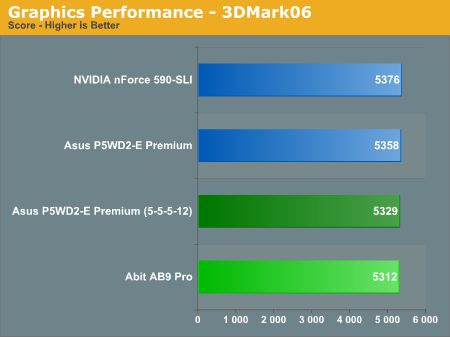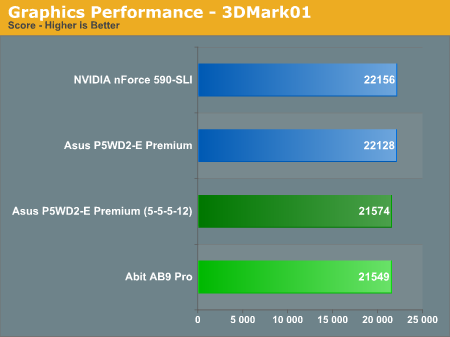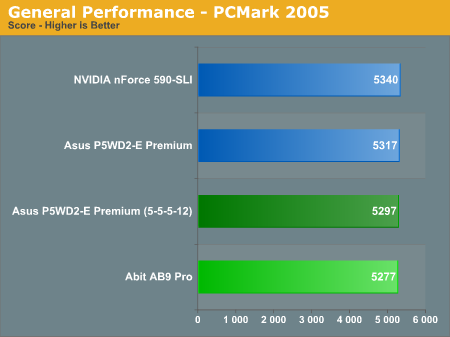Abit AB9 Pro: A sneak peek at Intel's new P965 chipset
by Gary Key on July 3, 2006 3:45 AM EST- Posted in
- Motherboards
Synthetic Graphics Performance
The 3DMark series of benchmarks developed and provided by Futuremark are among the most widely used tools for benchmark reporting and comparisons. Although the benchmarks are very useful for providing apple to apple comparisons across a broad array of GPU and CPU configurations, they are not a substitute for actual application and gaming benchmarks. In this sense we consider the 3DMark benchmarks to be purely synthetic in nature but still valuable for providing consistent measurements of performance.


In our first tests, each platform score is so close that there is no winner here. In the memory and CPU sensitive 3DMark01 benchmark we see the Asus and Abit boards scoring extremely close at the same memory timings. Although we have not reported memory benchmarks scores in this article, the Abit and Asus boards performed almost identically at the same settings indicating the P965 Express chipset will have excellent memory performance.
General System Performance
The PCMark05 benchmark developed and provided by Futuremark was designed for determining overall system performance for the typical home computing user. This tool provides both system and component level benchmarking results utilizing subsets of real world applications or programs. This benchmark is useful for providing comparative results across a broad array of graphics cards, CPUs, hard disks, and memory configurations and it also includes some multithreading results. In this sense we consider the PCMark benchmark to be both synthetic and real world in nature while providing consistency in our benchmark results.

The margins are extremely close in the PCMark05 results but the NVIDIA platform continues to show a very slight advantage over the Intel platform. While looking at the individual test results, we noticed the Abit board matched the other boards in the graphics tests and finished slightly behind in the multitasking tests due to the memory settings. We also noticed the NVIDIA nForce 500 Intel Edition board had 19% better performance than either Intel board in the XP Hard Disk Drive Startup test, with the ICH8R Abit performing 4% better than the ICH7R on the Asus.
The 3DMark series of benchmarks developed and provided by Futuremark are among the most widely used tools for benchmark reporting and comparisons. Although the benchmarks are very useful for providing apple to apple comparisons across a broad array of GPU and CPU configurations, they are not a substitute for actual application and gaming benchmarks. In this sense we consider the 3DMark benchmarks to be purely synthetic in nature but still valuable for providing consistent measurements of performance.


In our first tests, each platform score is so close that there is no winner here. In the memory and CPU sensitive 3DMark01 benchmark we see the Asus and Abit boards scoring extremely close at the same memory timings. Although we have not reported memory benchmarks scores in this article, the Abit and Asus boards performed almost identically at the same settings indicating the P965 Express chipset will have excellent memory performance.
General System Performance
The PCMark05 benchmark developed and provided by Futuremark was designed for determining overall system performance for the typical home computing user. This tool provides both system and component level benchmarking results utilizing subsets of real world applications or programs. This benchmark is useful for providing comparative results across a broad array of graphics cards, CPUs, hard disks, and memory configurations and it also includes some multithreading results. In this sense we consider the PCMark benchmark to be both synthetic and real world in nature while providing consistency in our benchmark results.

The margins are extremely close in the PCMark05 results but the NVIDIA platform continues to show a very slight advantage over the Intel platform. While looking at the individual test results, we noticed the Abit board matched the other boards in the graphics tests and finished slightly behind in the multitasking tests due to the memory settings. We also noticed the NVIDIA nForce 500 Intel Edition board had 19% better performance than either Intel board in the XP Hard Disk Drive Startup test, with the ICH8R Abit performing 4% better than the ICH7R on the Asus.










33 Comments
View All Comments
JarredWalton - Monday, July 3, 2006 - link
Corrected - the retail HSF was used, but it doesn't really matter since we didn't perform thorough overclocking, noise, or temperature testing yet. As mentioned in the article, we're waiting for a new BIOS release with memory timing adjustments before we do that.Heidfirst - Monday, July 3, 2006 - link
"This heatsink is part of the Abit Silent OTES technology that includes a heatpipe system and additional passive cooling for the VRM components. This system kept the MCH cool enough that additional chipset voltage was not a factor in our overclocking tests. Our only concern is the lifespan of the fanbut it is very quiet during operation"What fan?
JarredWalton - Monday, July 3, 2006 - link
Sorry - that was a fragment from an earlier article that slipped in. No fans. :)ALCX - Monday, July 3, 2006 - link
You didn't mention anything about how well this board overclocks! I would think with this 'stable' power and the D805 you would have an excellent opportunity. I'm also thinking getting a mboard like this with a $100 D805 and wait out Conroe supply issue/price until XMAS....ALCX
jones377 - Monday, July 3, 2006 - link
Do you have any plans to investigate I/O performance on this chipset? Those Winrar benches suggests these were vastly improved somehow. Memory latency/bandwidth benchmarks would be nice too. All compared to 975x, nvidia and ATI chipsets (for the Intel platform).mine - Saturday, July 8, 2006 - link
yes rightthis is what I am exspecting from anand in near future
if you like the info a little bit earlier
over@ xs
Chadder007 - Monday, July 3, 2006 - link
Im thinking about getting a motherboard like this and a Pentium D 805....and then waiting for the prices to go down and performance to go up for the Core 2's after maybe 1 year to upgrade.rqle - Monday, July 3, 2006 - link
I prefer a next gen board without the floopy, am still waiting. Keep PATA, well, third party chipset now, but kill off the floopy.Calin - Tuesday, July 4, 2006 - link
I'm all for it too - as long as you can install Windows on any computer without needing a floppy disk driveMacGuffin - Monday, July 3, 2006 - link
Or atleast X4 physical connectors, if X16 slots make things cramped for capacitors and other parts on the board. And what's up with this trend of 5/6 expansion slots on high-end motherboards? There was a time when most boards had 7 expansion slots. I guess the elaborate heatpipe mechanisms for 2-chip core logic interfere (eg. M2N-SLI vs. M2N32-SLI) with more expandability.
This is going to be a good year for technology!